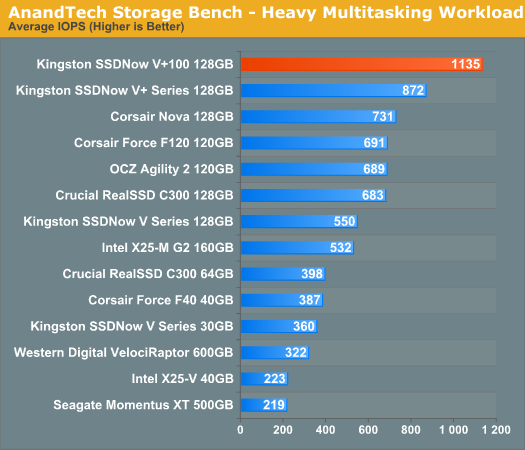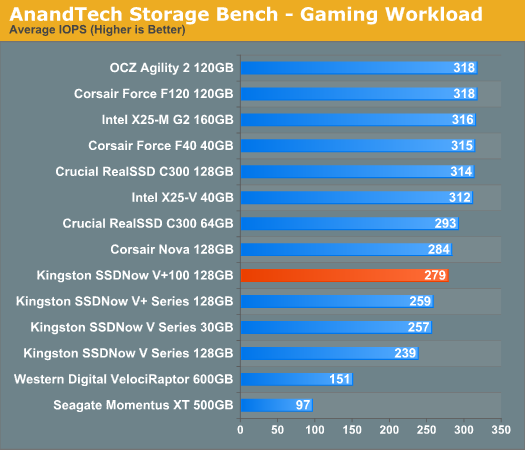Kingston SSDNow V+100 Review
by Anand Lal Shimpi on November 11, 2010 3:05 AM EST- Posted in
- Storage
- SSDs
- Kingston
- SSDNow V+100
AnandTech Storage Bench
To avoid any potential optimizations for industry standard benchmarks and to provide another example of real world performance we've assembled our own storage benchmarks that we've creatively named the AnandTech Storage Bench.
The first in our benchmark suite is a light/typical usage case. The Windows 7 system is loaded with Firefox, Office 2007 and Adobe Reader among other applications. With Firefox we browse web pages like Facebook, AnandTech, Digg and other sites. Outlook is also running and we use it to check emails, create and send a message with a PDF attachment. Adobe Reader is used to view some PDFs. Excel 2007 is used to create a spreadsheet, graphs and save the document. The same goes for Word 2007. We open and step through a presentation in PowerPoint 2007 received as an email attachment before saving it to the desktop. Finally we watch a bit of a Firefly episode in Windows Media Player 11.
There’s some level of multitasking going on here but it’s not unreasonable by any means. Generally the application tasks proceed linearly, with the exception of things like web browsing which may happen in between one of the other tasks.
The recording is played back on all of our drives here today. Remember that we’re isolating disk performance, all we’re doing is playing back every single disk access that happened in that ~5 minute period of usage. The light workload is composed of 37,501 reads and 20,268 writes. Over 30% of the IOs are 4KB, 11% are 16KB, 22% are 32KB and approximately 13% are 64KB in size. Less than 30% of the operations are absolutely sequential in nature. Average queue depth is 6.09 IOs.
The performance results are reported in average I/O Operations per Second (IOPS):

The higher capacity SandForce drives rule the roost here, but the C300, X25-M G2 and V+100 are not too far behind. Despite its age, Intel's X25-M G2 performs very well in our light usage test. The V+100 isn't far behind thanks to its 8.5% improvement over the original V+.
As far as small capacity drives go, the Corsair Force F40 and other similarly sized SandForce drives are the clear winners here. Crucial's 64GB RealSSD C300 is quicker than the X25-V, but no match for the 40GB SF drive.
If there’s a light usage case there’s bound to be a heavy one. In this test we have Microsoft Security Essentials running in the background with real time virus scanning enabled. We also perform a quick scan in the middle of the test. Firefox, Outlook, Excel, Word and Powerpoint are all used the same as they were in the light test. We add Photoshop CS4 to the mix, opening a bunch of 12MP images, editing them, then saving them as highly compressed JPGs for web publishing. Windows 7’s picture viewer is used to view a bunch of pictures on the hard drive. We use 7-zip to create and extract .7z archives. Downloading is also prominently featured in our heavy test; we download large files from the Internet during portions of the benchmark, as well as use uTorrent to grab a couple of torrents. Some of the applications in use are installed during the benchmark, Windows updates are also installed. Towards the end of the test we launch World of Warcraft, play for a few minutes, then delete the folder. This test also takes into account all of the disk accesses that happen while the OS is booting.
The benchmark is 22 minutes long and it consists of 128,895 read operations and 72,411 write operations. Roughly 44% of all IOs were sequential. Approximately 30% of all accesses were 4KB in size, 12% were 16KB in size, 14% were 32KB and 20% were 64KB. Average queue depth was 3.59.

This is another one of those SYSMark-like situations. The old Toshiba controller did just awesome in our heavy multitasking workload and the new update does even better. At 1135 IOPS, the V+100 is 55% faster than the Indilinx based Corsair Nova. Thanks to the incompressible nature of much of the data we're moving around in this benchmark the SandForce drives don't do so well. Although not pictured here, the 256GB C300 would be #2 - still outperformed by the V+100.
The gaming workload is made up of 75,206 read operations and only 4,592 write operations. Only 20% of the accesses are 4KB in size, nearly 40% are 64KB and 20% are 32KB. A whopping 69% of the IOs are sequential, meaning this is predominantly a sequential read benchmark. The average queue depth is 7.76 IOs.

The perplexing nature of the V+100 continues here. While it boasts great sequential read numbers, the smaller and somewhat random accesses drop the V+100 behind the SandForce and Crucial SSDs.










96 Comments
View All Comments
eckre - Saturday, November 13, 2010 - link
So this seems like a perfect drive for a RAID because of it's aggressive always on garbage collection would make up for lack of TRIM support. ?Am I correct? Thoughts?
JohnWPB - Saturday, November 13, 2010 - link
I have built probably 10 pc's in the last 2 yrs, and wonder if adding a SSD as a boot drive would be worth the effort.I see you guys making lots of comments, but as a newbie on SSD's, I would really like to see a thread on how to introduce a SSD to a system that has a bunch of SATA drives.
Exactly how does one go about installing Windows XP Pro? I imagine that I should disconnect my SATA drives and just hook up the SSD and then do a CD install?
Can programs like CasperXP ( mirror imaging program ), be used to do a mirror image backup from an SSD to a Sata drive ( C: boot drive SSD to D: mirror drive SATA ).
My apologies if this was posted in the wrong thread.
Out of Box Experience - Saturday, November 20, 2010 - link
QUOTE:Exactly how does one go about installing Windows XP Pro? I imagine that I should disconnect my SATA drives and just hook up the SSD and then do a CD install?
---------------------------------------------------------------------------------------------------------
You are correct as far as I can tell...
I just spent the past 2 days retesting the copy/paste speed of a Vertex 2 with the alignment tweak recommended by OCZ
There was no speed benefit resulting from the alignment of the partition as OCZ described
Copy and paste speed was still a miserable 3.6 megabutes per second
But just to be on the safe side, I will start using ONLY Intel SSD's with Windows XP
Anand says Intel controllers are alignment agnostic and should be the best for non-compressible data under XP
So, untill other SSD manufacturers start making alignment agnostic controllers that are capeable of doing a copy and paste faster than my 5400RPM laptop drive under XP, I think I'll just stick with Intel
(Better Flash Quality as well)
Ezekeel - Saturday, November 13, 2010 - link
Hi Anand,you noted that due to the aggressive garbage-collection this SSD will have a large write-amplification, so the flash will wear-out more quickly. What would happen when using this SSD with an OS that supports TRIM? Will TRIM support the internal GC and lead to a smaller write-amplification and thus a longer lifetime of the SSD?
mpx - Sunday, November 14, 2010 - link
Can you test how VMs behave on SSD? I understand it's partially there in synthetic IOPS and bandwith tests - that show what can you get max. from these drives. But "normal" load from multiple VMs should be different than normal load from a single OS, so drives that do good at normal load in current test migth be not performant under normal load of multiple VMs.This test with few VMs makes sense for larger drives (160, 256GB), as there just won't be enough place for multiple OSes on small drives. Also longevity becomes more important when you have few times larger load.
tecknurd - Sunday, November 14, 2010 - link
I use Linux and its TRIM command support is sparse. Finally a drive that does not require the TRIM command. I know it comes at a cost of more wear and tear, but I do not mind because pros out weighs the cons. It will give me no noise from the storage system and it be about 60 times quicker than my hard drive to access files. I do not think $280 for 128 GB is not a bad deal for a SSD that does not require the TRIM command to function great. Though, one thing that comes to mind is does the Kingston SSDNow V+100 come with ECC because all hard drives includes ECC for data integrity.Ezekeel - Sunday, November 14, 2010 - link
Why sparse? The kernel supports TRIM since 2.6.33 (early 2010).tecknurd - Wednesday, November 17, 2010 - link
True, but the file system also have problems with SSD. Not all file system in Linux are SSD aware. EXT3 and EXT4 does not have good support to handle SSD.Ezekeel - Friday, November 19, 2010 - link
Linux filesystems ext3/ext4 are designed for magnetic drives - but that is also true for ntfs and hfs+, so the problems with SSD are not unique to Linux. However, it is true that while at least Windows7 does some automatic optimizations, you have to configure everything manually under Linux.sprockkets - Sunday, November 21, 2010 - link
All you have to do is format the drive with ext4, add the discard option, and you are set. TRIM is enabled automatically in the background; no need to manually run the command anymore.Even with the latest firmwares, this isn't an issue anyway.